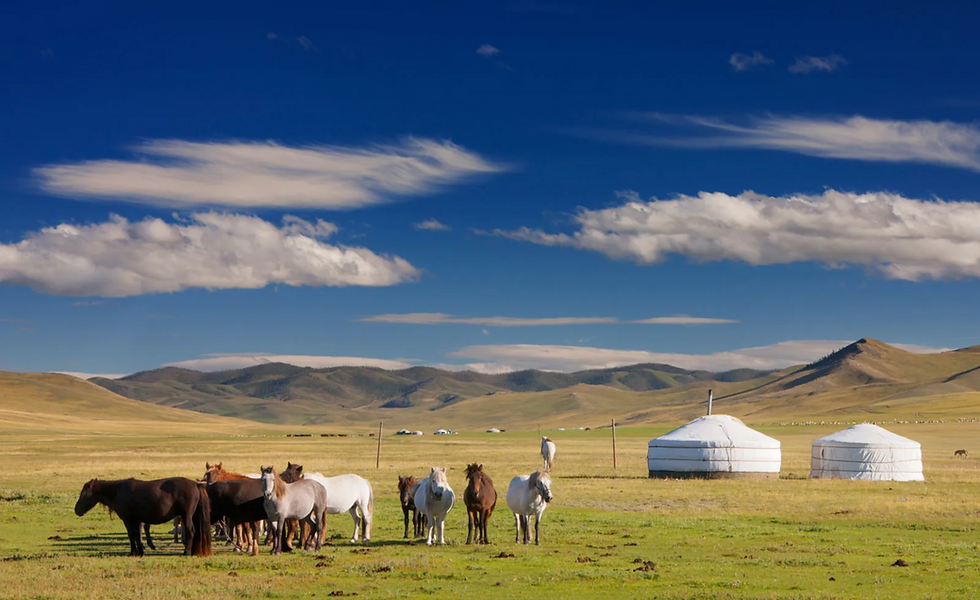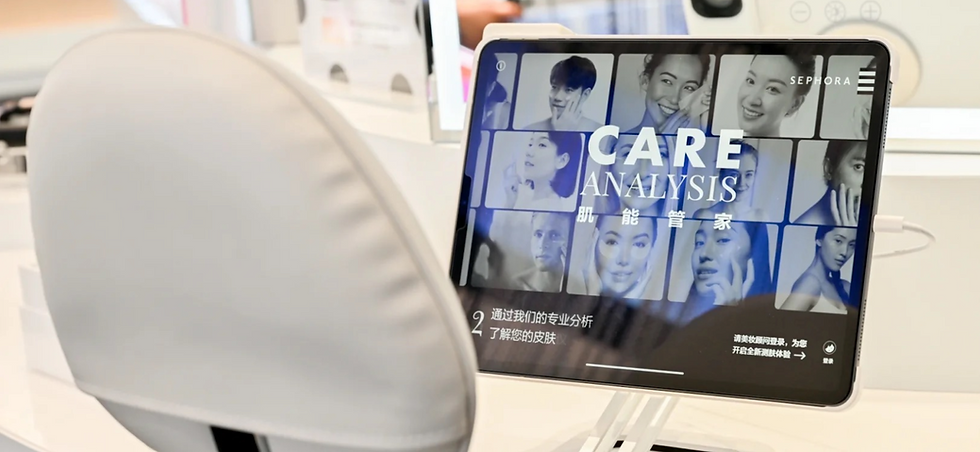THE BEAUTY RACE K vs J vs C
- SMS USYD

- Jul 6
- 7 min read

By Kanoie H, Elizabeth P, and Tatiana D
Welcome to the global beauty race–where K-, J-, and C-Beauty aren’t just routines, they’re contenders. Behind every cleanser, serum, or snail slime sheet mask is a deeper game: a race not just for the skin, but for hearts, minds and global dominance.
From Seoul to the vast steppes of Mongolia, K-Beauty’s glow has gone global. But what makes K-Beauty so globally contagious, especially in emerging markets like Mongolia, where over 70% of the population actively uses Facebook [1], and influencer marketing is just beginning to take root [2], [4]?

Mongolia, long defined by its nomadic heritage and deep-rooted customs, now stands at the frontier of digital change [3]. Consumers in Mongolia are most drawn to influencers who provide educational and relatable content [5], with surprising and creative messaging often prompting the most engagement [6]. This environment has become fertile ground for cosmetics and fashion ads–especially those riding the wave of the K-Beauty boom [7].
To better understand this global beauty boom, let’s break it down the only way that feels right: as a skincare routine!
Step 1: Cleanser - Clearing the Slate with K-Beauty’s Innovation
K-Beauty, powered by youth culture and digital fluency, has cleansed the beauty world of monotony [8], spreading virally through TikTok hauls and Instagram reels and formulating global digital communities [9]. From Etude’s playful packaging, Cosrx’s quirky ingredients (snail mucin, anyone?) to brands promoting the “10-step routine”, it’s safe to say the rise of K-Beauty has been anything but conventional. Here, self-care becomes both spectacle and ritual where layering more steps, more products, and more meaning into the act of ‘looking after’ yourself. In this world, skincare becomes an “affordable luxury” where it is a way to consume your way into confidence and belonging. In the midst of higher levels of body dissatisfaction among women worldwide [10], K-Beauty’s accessible luxury positions itself as a cure, subtly implying that with enough steps, effort, and product, beauty is within reach.

But it’s not just pores getting purified. Influencers have become the cleansers of brand image, helping K-Beauty create the basis for trust and emotional resonance with consumers [11]. Despite the innovativeness of using salmon DNA or snail mucin in their products, unless strategically paired with influencers, product exposure alone doesn't sway consumers [12]. Think of it as an active ingredient: effective, but only when formulated just right. The influence of a well-known figure, take BLACKPINK as an example, can clear any initial doubts or hesitations, creating the perfect base for product acceptance and commitment [13]. BLACKPINK’s partnership with Moonshot is a perfect example of how product exposure alone doesn’t guarantee success. With BLACKPINK being seen as symbols of empowerment, their makeup products transcend mere cosmetics, offering a tool for self-expression and confidence. This collaboration enhances Moonshot’s brand image, aligning it with a sense of empowerment that resonates with consumers which drives purchase intention [14].
Step 2: Toner - Invisible Bonds that Build Trust in the K-Beauty World
We understand that popular K-pop brands do help clear a brand’s image and turn it in a new direction, but why? The answer lies in the subtle but powerful force of parasocial relationships which are the emotional bonds fans form with idols who may never know they exist. These one-sided connections act like toner: invisible, often overlooked, but essential in preparing the emotional surface for everything that follows. Fans don’t just admire idols, they feel personally invested in them, and buying what their idols wear becomes an act of devotion [15]. In Indonesia, K-pop fans, even those highly aware of influencer marketing tactics, still showed strong purchase intent and engagement [16]. This is because the act of purchasing feels emotionally fulfilling, where supporting idols isn’t just consumption, it’s connection [17]. This silent loyalty helps explain why K-Beauty spreads with such intensity, while J-Beauty and C-Beauty, though globally respected, remains more reserved. Just like toner, parasocial bonds work in the background, anchoring the shine, and building a base of trust that lasts far beyond first impressions.
Step 3: Serum - Layering the Potent Innovation of C-Beauty with an extra drop of J-Beauty
Now we layer in the high-concentration, tech-forward power of C-Beauty. Backed by giants like Alibaba and Tencent, C-Beauty embraces AI-powered customisation, virtual influencers, and gamified shopping experiences [18]. With China’s strategic push to become a global AI leader, the C-Beauty landscape has embraced this digital transformation [19]. A key catalyst in this shift is Douyin, China’s domestic version of TikTok, which commands the daily attention of over half the country’s netizens. C-Beauty brands actively partner with Douyin to capitalise on its addictive, algorithm-driven ecosystem and get their products out to consumers [20]. Powered by personalised user personas, and collaborative filtering, Douyin’s recommendation engine delivers precisely tailored beauty content that aligns with user preferences in real time.

Yet instead of a smooth, adaptable product that works globally, C-Beauty’s formula to marketing, which thrives on platforms like Douyin, is like having a serum that works great on one skin type but leaves others disappointed. However, globally, the integration of Chinese platforms into the beauty marketing mix creates friction. Between Western media skepticism, take America’s claims that Tiktok “screams” of national security concerns [21], linguistic/cultural barriers and state censorship, C-Beauty hasn't been able to achieve cultural exportability because its success is deeply intertwined with Chinese digital infrastructure and societal conditions which create a disconnect for global consumers. In this way, C-Beauty is like a high-powered vitamin C serum that is potent, immediate, and tailored for visible impact only in its targeted areas.
Alternatively, where C-Beauty energises, J-Beauty soothes. J-Beauty works like the perfect serum. It’s subtle, quiet, but indispensable to the overall routine. Grounded in ritual, simplicity, and longevity, J-Beauty is the quiet achiever, priorotising luxury over likes [22]. Brands like Shiseido and SK-II offer a philosophy steeped in centuries of skincare wisdom, focused on refinement, balance, and time-honored ingredients that make it globally respected, but not quite as culturally contagious as its K-Beauty counterpart.

K-Beauty, by contrast, targets a younger audience seeking the coveted “glass skin” which promotes flawlessly smooth, luminous, and transparent. Meanwhile, J-Beauty focuses on achieving “Mochi skin,” characterised by softness, suppleness, plumpness, and preserving natural beauty. Here, the core difference lies in K-Beauty’s pursuit of perfection versus J-Beauty’s emphasis on preserving and enhancing natural beauty. Therefore, thanks to its strong youth appeal, K-Beauty spreads faster and farther across borders.
Step 4: Moisturiser - Locking in Global Appeal with K-Beauty
Back to K-Beauty, the ultimate moisturiser in this routine. Their edge lies in cultural exportability. It’s not just skincare, it’s a lifestyle. Unlike the slow-absorbing essence of J-Beauty or the potent but targeted formula of C-Beauty, K-Beauty's glow is made to travel. But as we have explored throughout not only the K-Beauty industry but across markets, what really helps to “lock in” its global appeal is its strategic influencer marketing. As we've explored across both industry and fan behavior, what truly helps “lock in” its global appeal is the emotional architecture behind it, that being the strategic influencer marketing powered by parasocial intimacy.
Step 5: SPF - The Final Layer of Reflection
K-Beauty doesn’t simply sell skincare, it sells proximity to idols, identity through aesthetics, and emotional fulfillment through consumption. They build community, aspiration, and loyalty. This unique fusion of innovation, accessibility, and emotional resonance creates a formula that doesn’t just sit on the skin, it sinks in globally and ‘protects’ K-Beauty’s position in the spotlight.

References
Kemp, S. (2024, February 23). Digital 2024: Mongolia. DataReportal. https://datareportal.com/reports/digital-2024-mongolia
Nomin, E., Park, S.-M., & Kim, M.-S. (2023, December 31). The Effect of Influencer and Contents Characteristics on Purchase Intention: Focusing on Mongolian Consumers. The Institute of Management and Economy Research. The Institute of Management and Economy Research. https://doi.org/10.32599/apjb.14.4.202312.115
[20] Hofstede Insights. (n.d.). Country comparison: Mongolia. The Culture Factor. Retrieved April 29, 2025, from https://www.theculturefactor.com/country-comparison-tool?countries=mongolia
[16] GANTSEND, G., & Kang, M. J. (2023). The Effect of Beauty Influencer Characteristics on Relationship Continuation Intention and Purchase Intention - Focusing on Mongolian Consumers -. International Journal of Internet, Broadcasting and Communication , 15 (1), 33–39. https://doi.org/10.7236/IJIBC.2023.15.1.33
Nomin, E., Park, S.-M., & Kim, M.-S. (2023, December 31). The Effect of Influencer and Contents Characteristics on Purchase Intention: Focusing on Mongolian Consumers. The Institute of Management and Economy Research. The Institute of Management and Economy Research. https://doi.org/10.32599/apjb.14.4.202312.115
[18] Lkhagvasuren, T. (2014). Marketing of small and medium sized enterprises in Mongolia. International Journal of Technology Enhancements and Emerging Engineering Research, 2(5), 33. https://citeseerx.ist.psu.edu/document?repid=rep1&type=pdf&doi=c6cc0f10614397d58af18b27fe7d5b2f7d5f524c
GANTSEND, G., & Kang, M. J. (2023). The Effect of Beauty Influencer Characteristics on Relationship Continuation Intention and Purchase Intention - Focusing on Mongolian Consumers -. International Journal of Internet, Broadcasting and Communication , 15 (1), 33–39. https://doi.org/10.7236/IJIBC.2023.15.1.33
Martins Viana, E. (2024, October 23). The scientific innovation of Korean skincare: A revolutionary model? LinkedIn. https://www.linkedin.com/pulse/scientific-innovation-korean-skincare-revolutionary-martins-viana-ikkac/
Meade-Palmer, S. N. (2023, November 29). K-Beauty: Where Tradition Meets Empowering Tech-Driven Transformation - Technopreneurship360. https://technopreneurship360.com/2023/11/29/k-beauty-where-tradition-meets-tech-driven-transformation/
Abdoli, Marzieh, et al. “Cultural Differences in Body Image: A Systematic Review.” Social Sciences, vol. 13, no. 6, 1 June 2024, p. 305, www.mdpi.com/2076-0760/13/6/305, https://doi.org/10.3390/socsci13060305.
Wang, L., & Lee, J. H. (2021). The Impact of K-beauty Social Media influencers, sponsorship, and Product Exposure on Consumer Acceptance of New Products. Fashion and Textiles, 8(1). https://doi.org/10.1186/s40691-020-00239-0
Ibid.
NIKEN AYU VINATA, & Nurrani Kusumawati. (2021). THE INFLUENCE OF BLACKPINK AS TOKOPEDIA’S BRAND AMBASSADOR ON BRAND AWARENESS, BRAND IMAGE, AND CONSUMER PURCHASE DECISIONS. 07(10), 6–11. https://www.researchgate.net/publication/357402554_THE_INFLUENCE_OF_BLACKPINK_AS_TOKOPEDIA
Sánchez, Sergio Ibáñez , et al. “Influencers and Brands Successful Collaborations: A Mutual Reinforcement to Promote Products and Services on Social Media.” ResearchGate, May 2021, www.researchgate.net/publication/351851006_Influencers_and_brands_successful_collaborations_A_mutual_reinforcement_to_promote_products_and_services_on_social_media.
Que, Y., Gilardi, F., & Martin, P. (2023). Love in Imagination: A Comparative Analysis Between Chinese K-pop Fans and Esports Fans Regarding Their Parasocial Interaction and Relationship Towards the Virtual Idol Group K/DA. In Esports in the Asia-Pacific (pp. 115–136). Palgrave Macmillan. https://doi.org/10.1007/978-981-99-3796-7_6
Ibid
Ibid
Locke, J. (2025, March 20). The digital transformation of the beauty industry: AI, gamification and the metaverse. Medium; Digital Society. https://medium.com/digital-society/the-digital-transformation-of-the-beauty-industry-ai-gamification-and-the-metaverse-926b5c2fdb08
Ibid
ibid
McDaniel, C. (2020, May 8). 40% Of Americans Say They Won’t Buy “Made In China” But Do They Mean It? Forbes. https://www.forbes.com/sites/christinemcdaniel/2020/05/28/40-of-americans-say-they-wont-buy-made-in-china-but-do-they-mean-it/
Inoue, M. (2019, December 23). To Understand J-Beauty, You Have to Understand Its History. Beautytap.com. https://beautytap.com/2019/12/history-of-japanese-beauty?SuperSocializerAuth=LiveJournal




















Comments